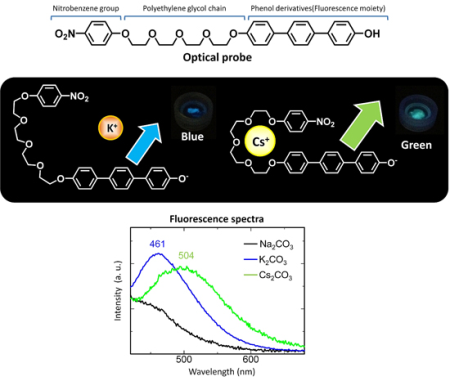The NIMS International Center for Materials Nanoarchitectonics (WPI-MANA) developed a supermolecular material which makes it possible to visualize the distribution of cesium on the surface of solids and in living organisms by fluorescence.
 Molecular structure, mechanism of fluorescence, and fluorescence spectrum of the optical probe substance for cesium detection.
Molecular structure, mechanism of fluorescence, and fluorescence spectrum of the optical probe substance for cesium detection.
A team headed by Dr. Taizo Mori (Postdoctoral Researcher) and Dr. Jonathan P. Hill (MANA Scientist) in Supermolecules Unit (Unit Director: Katsuhiko Ariga) of the International Center for Materials Nanoarchitectonics (WPI-MANA; Director-General: Masakazu Aono) at the National Institute for Materials Science (NIMS; President: Sukekatsu Ushioda), developed a supermolecular material which makes it possible to visualize the distribution of cesium on the surface of solids and in living organisms by fluorescence.
As a result of the accident at the Fukushima No. 1 Nuclear Power Plant following the Great East Japan Earthquake of March 2011, a large amount of radioactive substances leaked and contaminated a wide area. Among those substances, cesium 137, which is a radioactive isotope of cesium, has a long half-life of 30 years, and thus will continue to be a source of radiation in the future. The Japanese government has planned and implemented decontamination measures for the region which was contaminated by radioactive substances. However, if the distribution of cesium can be visualized, this decontamination work can be carried out more efficiently, and a reduction in the amount of contaminated waste generated by the decontamination work can also be expected. At present, research and development of a camera that enables visualization of radioactive substances is being carried out with the cooperation of industry, academia, and government agencies.
This research group developed a fluorescent probe that detects cesium using supermolecular interaction. This optical probe emits green fluorescent light when it contains cesium, thereby enabling visual confirmation of cesium distributed on the surface of a solid. It has higher spatial resolution than the existing methods of detecting radioactive substances, and makes it possible to visualize the distribution of cesium with submillimeter accuracy. The technology for detection of cesium ions, not limited to radioactive isotopes, is expected to compensate for the weaknesses of these existing methods.
When alcohol in which this optical probe has been dissolved is sprayed on soil that contains cesium, and the soil is then irradiated with an ultraviolet light, only the spots that are contaminated with cesium emit green fluorescent light. Because this enables selective removal of only the cesium-contaminated spots, a large reduction in the amount of contaminated waste generated by decontamination work can be expected.
Furthermore, when alcohol in which the optical probe has been dissolved is sprayed on the cross section of the stem of a plant immersed in water that contains cesium, and is then irradiated with an ultraviolet light, only the parts that contain cesium emit green fluorescent light. In other words, a visual understanding of the diffusion behavior and accumulation process of cesium is possible.
The results of this research make it possible to visualize the distribution of cesium with submillimeter accuracy, and thus are expected to make an important contribution to higher efficiency in decontamination work, elucidation of the cesium diffusion and accumulation process, and related issues.
These research results are scheduled for online publication in the January 2013 issue of the scientific journal “Science and Technology of Advanced Materials.”
Source: http://www.nims.go.jp/